Light – Reflection and Refraction Class 10 Notes | CBSE Physics Chapter 10 (2025–26)
Light Reflection and Refraction Notes
If you're a CBSE Class 10 Science student, understanding the concepts of light, reflection, and refraction is essential. These notes offer a clear and complete summary of the chapter — including key definitions, formulas, laws, and solved examples — to support your exam preparation and revision. You can also download and print the PDF for easy offline study.
| Subject | Science (Physics) |
| Class | 10 |
| Board | CBSE |
| Chapter No. | 9 |
| Chapter Name | Light Reflection and Refraction |
| Type | Notes |
| Session | 2025-26 |
Table of Contents
Reflection of Light
The Laws of Reflection of Light
- The angle of incidence is equal to the angle of reflection,
- The incident ray, the normal to the mirror at the point of incidence, and the reflected ray, all lie in the same plane.
Formation of an image by a plane mirror:
- The image formed by a plane mirror is always virtual and erect.
- The size of the image is equal to that of the object.
Spherical Mirrors
- Such mirrors, whose reflecting surfaces are spherical, are called spherical mirrors.
- A spherical mirror, whose reflecting surface is curved inwards, that is, faces towards the center of the sphere, is called a concave mirror.
- A spherical mirror whose reflecting surface is curved outwards is called a convex mirror.
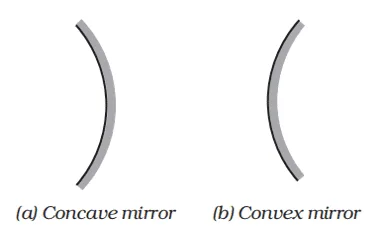
Some Important Terms:
- Pole (P)
- Center of Curvature (C)
- Radius of Curvature (R)
- Principal Axis
Principal focus of the concave mirror (F): When a number of rays parallel to the principal axis is falling on a concave mirror. The reflected rays all meet/intersect at a point on the principal axis of the mirror. This point is called the principal focus of the concave mirror
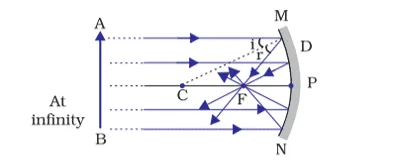
Principal focus of the convex mirror (F): When a number of rays parallel to the principal axis is falling on a convex mirror. The reflected rays appear to come from a point on the principal axis of the mirror. This point is called the principal focus of the convex mirror.
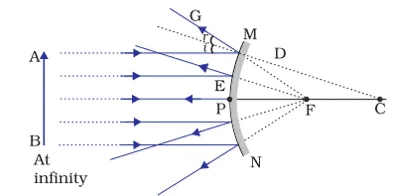
Focal length (f): The distance between the pole and the principal focus of a spherical mirror is called the focal length. It is represented by the letter f.
Aperture: The diameter of the reflecting surface of a spherical mirror is called its aperture. [the distance MN in the above figures]
Relationship between R (radius of curvature) and f (focal length):
R = 2f
Image Formation by Concave Mirror
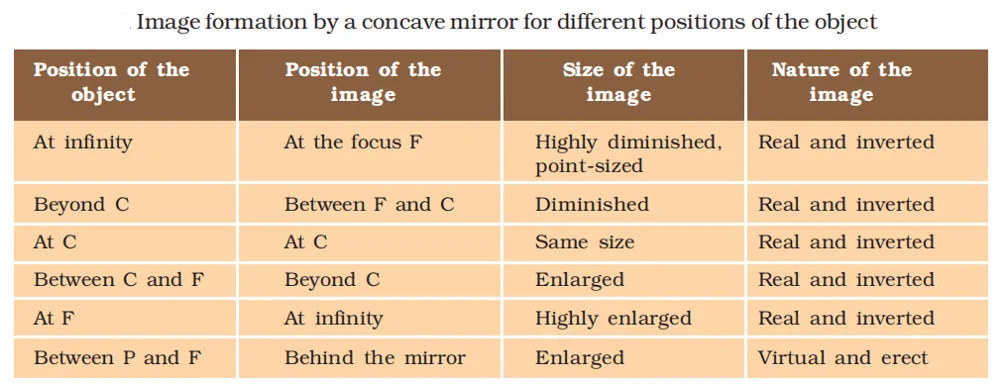
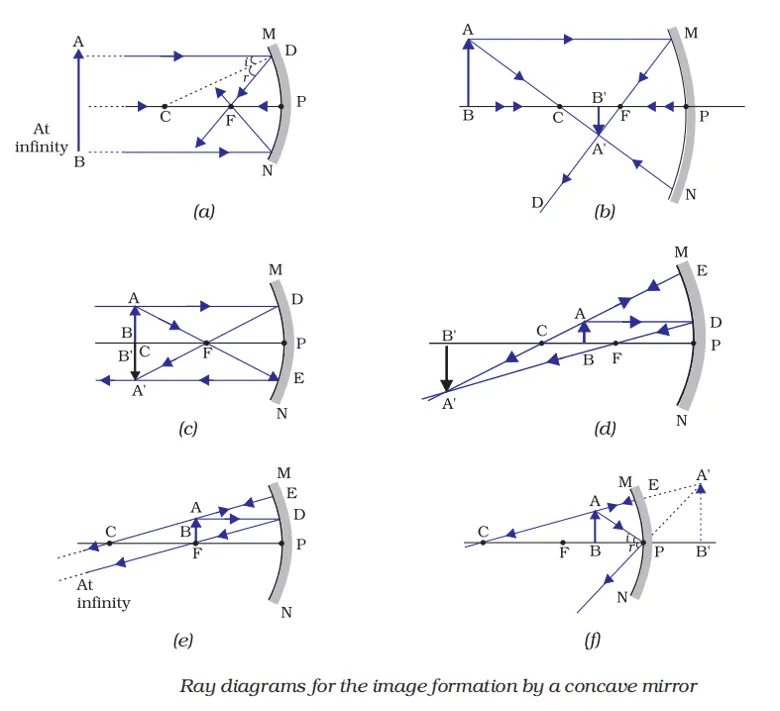
Uses of Concave Mirrors:
- Concave mirrors are commonly used in torches, searchlights, and vehicle headlights to get powerful parallel beams of light.
- They are used as shaving mirrors to see a larger image of the face.
- Dentists use concave mirrors to see large images of the teeth of patients.
- Large concave mirrors are used to concentrate sunlight to produce heat in solar furnaces.
Image Formation by Convex Mirror


Note: You can see a full-length image of a tall building/tree in a small convex mirror.
Uses of Convex Mirrors
- Convex mirrors are commonly used as rear-view (wing) mirrors in vehicles.
- Because:
- They always give an erect, though diminished, image.
- Also, they have a wider field of view as they are curved outwards
Sign Convention for Reflection by Spherical Mirrors

- The object is always placed to the left of the mirror. [i.e., object distance (u) is always taken as negative (-)].
- All distances parallel to the principal axis are measured from the pole of the mirror.
- The focal length of a convex mirror is positive and that of a concave mirror is negative.
Mirror Formula and Magnification
| Mirror Formula |  |
| Magnification |
- The height of the image should be taken as positive for virtual images and negative for real images.
- A negative sign in the value of the magnification indicates that the image is real.
- A positive sign in the value of the magnification indicates that the image is virtual.
Refraction of Light
Definition: Light does not travel in the same direction in all media. It appears that when traveling obliquely from one medium to another, the direction of propagation of light in the second medium changes. This phenomenon is known as the refraction of light.
Refraction through a Rectangular Glass Slab
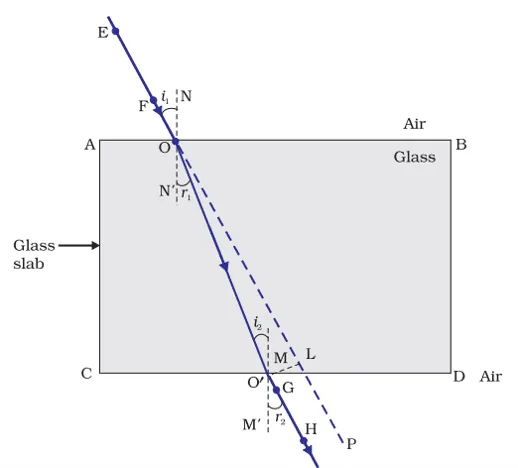
| EO | Incident ray |
| OO' | Refracted ray |
| O'H | Emergent ray |
| ∠EON | Angle of incidence |
| ∠N'OM | Angle of Refraction |
- The light ray at point O has entered from a rarer medium (air) to a denser medium (glass). Note that the light ray has bent towards the normal.
- At O′, the light ray has entered from glass to air, that is, from a denser medium to a rarer medium. The light here has bent away from the normal.
- The emergent ray is parallel to the direction of the incident ray because:
- The extent of bending of the ray of light at the opposite parallel faces AB (air-glass interface) and CD (glass-air interface) of the rectangular glass slab is equal and opposite. This is why the ray emerges parallel to the incident ray.
- The incident ray, the refracted ray, and the normal to the interface of two transparent media at the point of incidence, all lie in the same plane.
- The ratio of the sine of the angle of incidence to the sine of the angle of refraction is a constant, for the light of a given color and for the given pair of media. This law is also known as Snell’s law of refraction. (This is true for angle 0° < i < 90°)
If i is the angle of incidence and r is the angle of refraction, then,

The Refractive Index
Let v1 be the speed of light in medium 1 and v2 be the speed of light in medium 2. The refractive index of medium 2 with respect to medium 1 is given by the ratio of the speed of light in medium 1 and the speed of light in medium 2. This is usually represented by the symbol n21.

Similarly, the refractive index of medium 1 w.r.t. medium 2 is

If medium 1 is vacuum or air, then the refractive index of medium 2 is considered with respect to vacuum. This is called the absolute refractive index or simply the refractive index of the medium. It is simply represented as n2.

Meaning of the statement "The refractive index of water, nw = 1.33"
This means that the ratio of the speed of light in air and the speed of light in water is equal to 1.33.
Note: If the refractive index of medium x is nx and that of medium y is ny, then the refractive index of medium x w.r.t medium y is nxy = nx/ny.
Refraction by Spherical Lenses
Lens: A transparent material bound by two surfaces, of which one or both surfaces are spherical, forms a lens. This means that a lens is bound by at least one spherical surface. In such lenses, the other surface would be plane.
Convex Lens
- A lens may have two spherical surfaces, bulging outwards. Such a lens is called a double convex lens. It is simply called a convex lens.
- It is thicker in the middle as compared to the edges.
- Convex lens converges light rays as shown in the figure below. Hence convex lenses are also called converging lenses.

Concave Lens
- A double concave lens is bounded by two spherical surfaces, curved inwards. A double concave lens is simply called a concave lens.
- It is thicker at the edges than at the middle.
- Such lenses diverge light rays as shown in the figure below. Such lenses are also called diverging lenses.

Some Important terms
- Center of Curvatures (C1 and C2)
- Principal axis
- Optical center (O)
- Principal focus of convex lens (F): When several rays of light parallel to the principal axis fall on a convex lens, these rays, after refraction from the lens, converge to a point on the principal axis. This point on the principal axis is called the principal focus of the convex lens.
- Principal focus of concave lens (F): When several rays of light parallel to the principal axis fall on a concave lens, these rays, after refraction from the lens, appear to diverge from a point on the principal axis. This point on the principal axis is called the principal focus of the concave lens.
- Focal length (f): The distance of the principal focus from the optical center of a lens is called its focal length.
Image Formation by Convex Lens

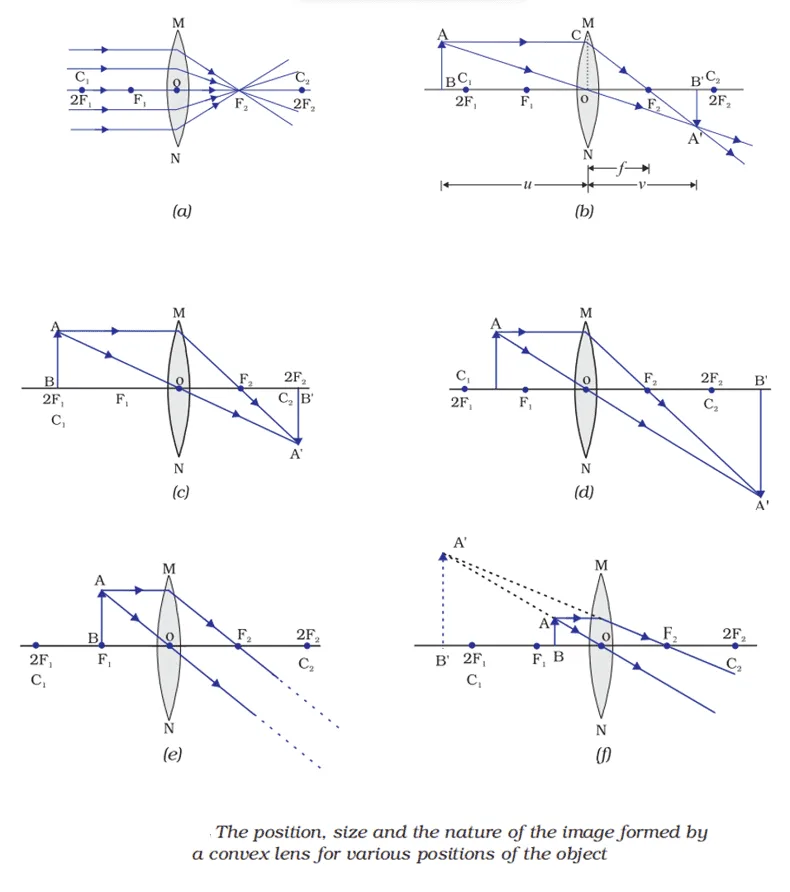
Image Formation by Concave Lens

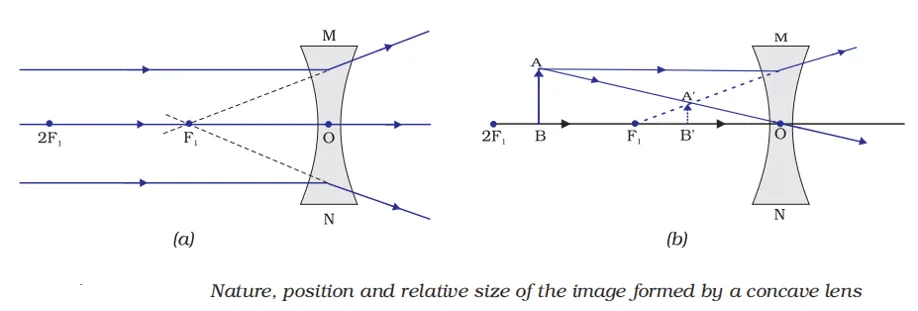
Sign Convention for Spherical Lenses
- The focal length of a convex lens is positive and that of a concave lens is negative.
- The object is always placed to the left of the lens. [i.e., object distance (u) is always taken as negative (-)].
- All distances parallel to the principal axis are measured from the optical center.
Lens Formula and Magnification
| Lens Formula |  |
| Magnification |
Power of a Lens
- The power of a lens is defined as the reciprocal of its focal length. It is represented by the letter P. The power P of a lens of focal length f is given by P = 1/f
- The SI unit of power of a lens is ‘dioptre’ (D)
- If f is expressed in meters, then, power is expressed in dioptres.
- 1 dioptre: 1 dioptre is the power of a lens whose focal length is 1 meter. 1D = 1m–1
- The power of a convex lens is positive and that of a concave lens is negative.
- Meaning of "The power of a lens is +2.0 D"
- The lens is convex.
- The focal length of the lens is + 0.50 m.
- Meaning of "The power of a lens is -2.5 D"
- The lens is concave.
- The focal length of the lens is -0.40 m.
🔦 Chapter 10: Light – Reflection and Refraction
📚 Class 10 Science | Physics | NCERT Solutions
🔹 Intext Questions (Page 168)
Q1. Define the principal focus of a concave mirror.
✅ Answer: The principal focus of a concave mirror is a point on its principal axis where light rays parallel to the axis converge after reflection.
Q2. The radius of curvature of a spherical mirror is 20 cm. What is its focal length?
✅ Answer:
Focal length (f) = R/2 = 20/2 = 10 cm
Q3. Name the mirror used in:
(a) solar furnaces
(b) rear-view mirrors of vehicles.
✅ Answer:
(a) Concave mirror (b) Convex mirror
🔹 Intext Questions (Page 171)
Q1. Find the focal length of a convex mirror whose radius of curvature is 32 cm.
✅ Answer:
f = R/2 = 32/2 = 16 cm
Q2. A concave mirror produces 3× magnified real image of an object. What is the distance of the object from the mirror?
✅ Answer:
For real image, m = -3
So, m = -v/u ⇒ -3 = -v/u ⇒ v = 3u
Using mirror formula:
Let’s assume f = known or calculate based on question.
(For board use: Apply mirror formula with values when f is given)
🔹 Intext Questions (Page 176)
Q1. Define the refractive index.
✅ Answer:
Refractive index (n) = Speed of light in vacuum / Speed of light in medium
Q2. Light enters from air to glass having refractive index 1.5. What is the speed of light in glass?
✅ Answer:
Speed in glass = c / n = (3 × 10⁸ m/s) / 1.5 = 2 × 10⁸ m/s
Q3. Which property of light leads to formation of shadow?
✅ Answer:
Rectilinear propagation of light
Q4. Which type of mirror can form a real image?
✅ Answer:
Concave mirror
🔹 Intext Questions (Page 178)
Q1. A ray of light traveling in air enters obliquely into water. Does the light bend towards or away from the normal? Why?
✅ Answer:
It bends towards the normal because water is denser than air.
Q2. Light bends when it travels from one medium to another. Why?
✅ Answer:
Because light changes speed when moving between media of different optical densities.
Q3. What happens when a ray of light strikes the surface of a transparent medium at right angles?
✅ Answer:
It passes undeviated along the normal (no bending).
🔹 Intext Questions (Page 180)
Q1. Define 1 dioptre of power of a lens.
✅ Answer:
Power of a lens = 1/f (in meters)
1 dioptre is the power of a lens with focal length of 1 meter.
Q2. A convex lens forms a real and inverted image of an object at 100 cm from it. If the image is of the same size as the object, what is the object distance?
✅ Answer:
For same size and real image, object = image = 2f
So, object distance = 100 cm
Q3. Find the power of a concave lens of focal length 2 m.
✅ Answer:
P = 100/f = 100/(-200) = –0.5 D
🔹 Back Exercise Questions (Pages 184–185)
Q1. Define principal focus of a concave mirror.
✅ Answer: Already given above.
Q2. The radius of curvature of a spherical mirror is 20 cm. What is its focal length?
✅ Answer: f = 10 cm
Q3. Name the mirror that
(a) can give erect image as well as inverted image.
(b) always gives erect image.
✅ Answer:
(a) Concave mirror (b) Convex mirror
Q4. What is the nature of the image formed by a convex mirror?
✅ Answer:
Virtual, erect, and diminished
Q5. Why do we prefer a convex mirror as a rear-view mirror in vehicles?
✅ Answer:
Because it gives a wider field of view and always forms erect, diminished images.
Q6. Find the focal length of a convex mirror whose radius of curvature is 32 cm.
✅ Answer: f = R/2 = 16 cm
Q7. A concave mirror forms a real image 40 cm from the mirror. The object is placed 60 cm from the mirror. Find its focal length.
✅ Answer:
Using mirror formula:
Q8. Find the position, nature and magnification of the image formed by a convex lens of focal length 10 cm when object is placed 15 cm away.
✅ Answer:
Use lens formula:
Image: Real, inverted, magnified
🔦 Chapter 10: Light – Reflection and Refraction
📚 Class 10 Physics | CBSE Previous Year Questions (PYQs)
🔹 1-Mark Questions
-
Which mirror is used as a rear-view mirror in vehicles? Why?
📅 CBSE 2019
✅ Answer: Convex mirror – it provides a wider field of view and always forms erect images. -
What is the focal length of a concave mirror whose radius of curvature is 24 cm?
📅 CBSE 2020
✅ Answer: f = R/2 = 24/2 = 12 cm -
Where should an object be placed in front of a convex lens to get its real, inverted, and same-size image?
📅 CBSE 2020
✅ Answer: At 2F (twice the focal length) -
What is the nature of the image formed by a plane mirror?
📅 CBSE 2017
✅ Answer: Virtual, erect, and same size as the object
🔹 2-Mark Questions
-
Differentiate between real and virtual images.
📅 CBSE 2018
✅ Answer:
| Real Image | Virtual Image |
|---|---|
| Formed on screen | Not formed on screen |
| Inverted | Erect |
-
Draw a ray diagram to show the formation of an image by a convex lens when an object is placed between F and 2F.
📅 CBSE 2019
✅ Answer: Diagram shows:
-
Image formed beyond 2F
-
Real, inverted, and magnified
-
State the laws of reflection.
📅 CBSE 2016
✅ Answer:
-
Incident ray, reflected ray, and normal lie in the same plane
-
Angle of incidence = angle of reflection
🔹 3-Mark Questions
-
An object is placed 20 cm in front of a concave mirror with a focal length of 10 cm. Find the position and nature of the image.
📅 CBSE 2020
✅ Answer:
-
Using mirror formula:
-
Image: Real, inverted, and same size (formed at 2F)
-
Why does a ray of light bend when it travels from one medium to another? Use a diagram to show refraction when light passes from air to glass.
📅 CBSE 2019
✅ Answer:
-
Due to change in speed
-
Bends toward normal when moving to denser medium
-
A ray of light is incident on a concave mirror such that it passes through its centre of curvature. What will be the path of the reflected ray? Justify your answer.
📅 CBSE 2022
✅ Answer:
-
It retraces its path because the angle of incidence = 0°.
🔵 5-Mark Questions
-
Draw a ray diagram for a concave mirror when:
(a) object is placed at C
(b) object is between F and C
(c) object is at F
(d) object is between F and pole
📅 CBSE 2023
✅ Answer:
Each position yields different types of images (real/inverted, magnified/diminished, virtual)
-
State the mirror formula. Derive it for a concave mirror. Solve a numerical: An object is placed at 15 cm in front of a concave mirror of focal length 10 cm. Find image distance and magnification.
📅 CBSE 2020
✅ Answer:
-
Mirror formula:
-
f = –10 cm, u = –15 cm
-
v = –30 cm; m = v/u = –30/–15 = 2
-
Explain the laws of refraction with the help of a diagram. Define refractive index and state its formula.
📅 CBSE 2018
✅ Answer:
-
1st Law: Incident ray, refracted ray, and normal lie in the same plane
-
2nd Law: Snell’s Law:
-
Refractive index = speed of light in vacuum / speed in medium
-
With the help of a ray diagram, show how a concave lens forms an image of an object placed in front of it. State the nature and position of the image.
📅 CBSE 2021 Sample Paper
✅ Answer:
-
Diagram: image between F and optical center
-
Nature: Virtual, erect, diminished
📌 Frequently Asked Concepts in CBSE Boards:
| Concept | Marks | Frequency |
|---|---|---|
| Mirror formula and numericals | 3M/5M | High |
| Ray diagrams for mirrors/lenses | 2M/3M | Very High |
| Laws of reflection/refraction | 2M | High |
| Real vs Virtual image / types of mirrors | 1M/2M | High |
| Refraction through convex/concave lens | 3M/5M | High |
| Power of lens (with formula) | 1M/2M | Moderate |


Comments
Post a Comment